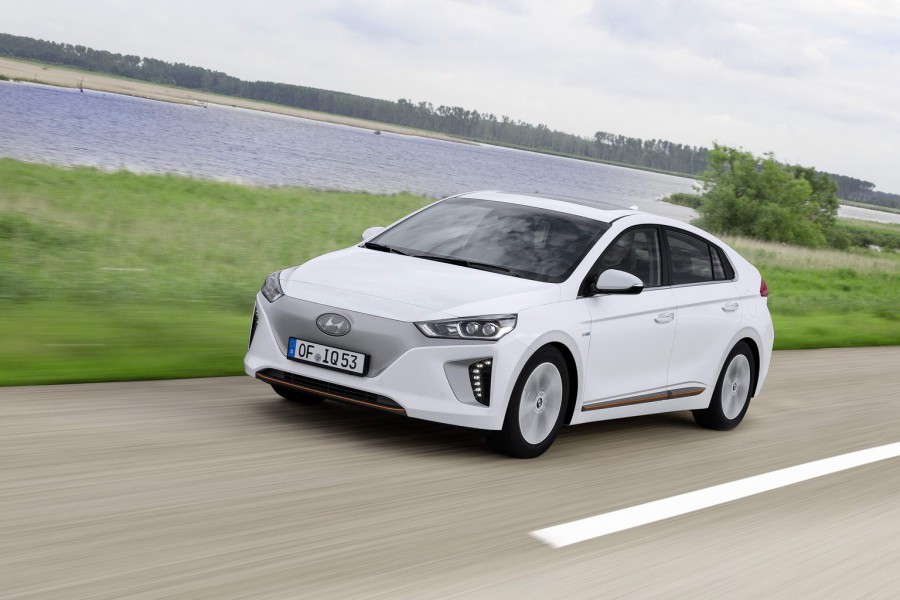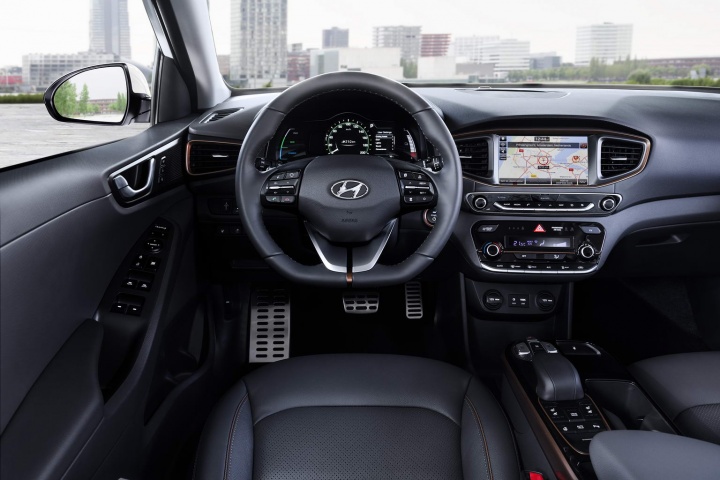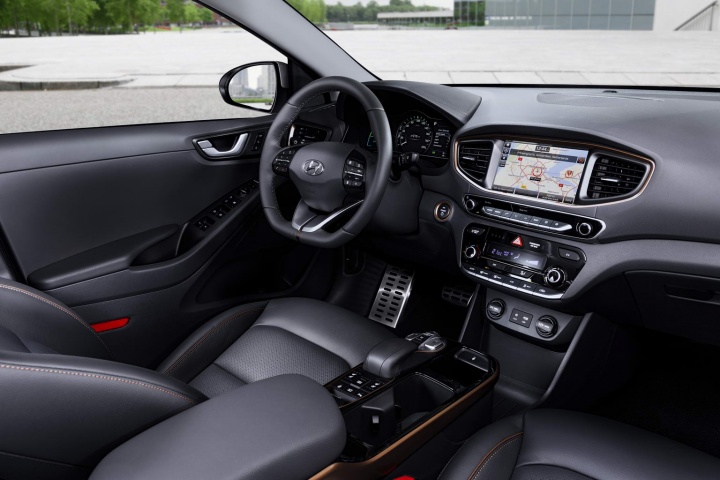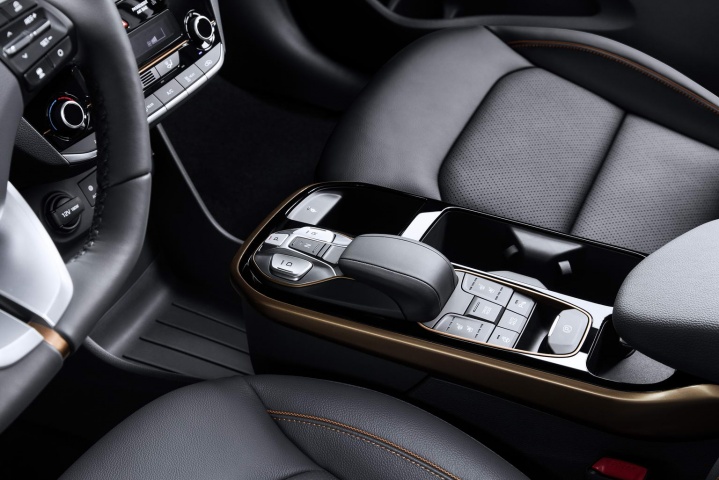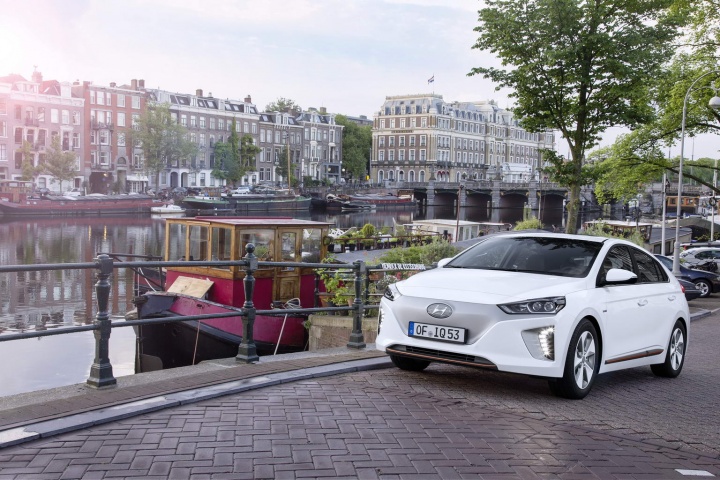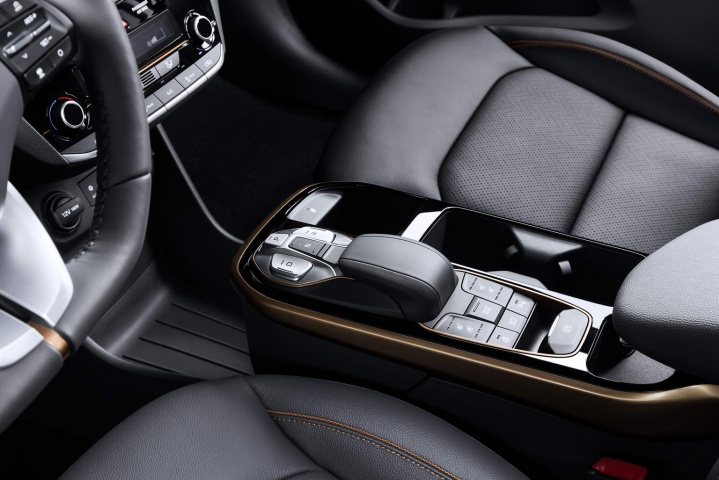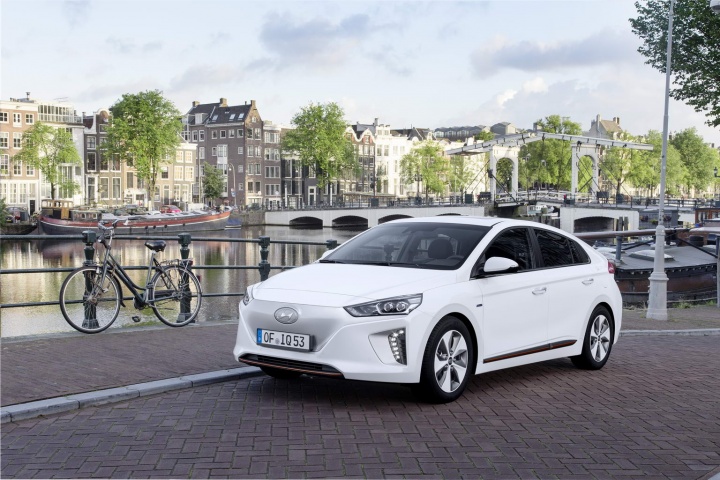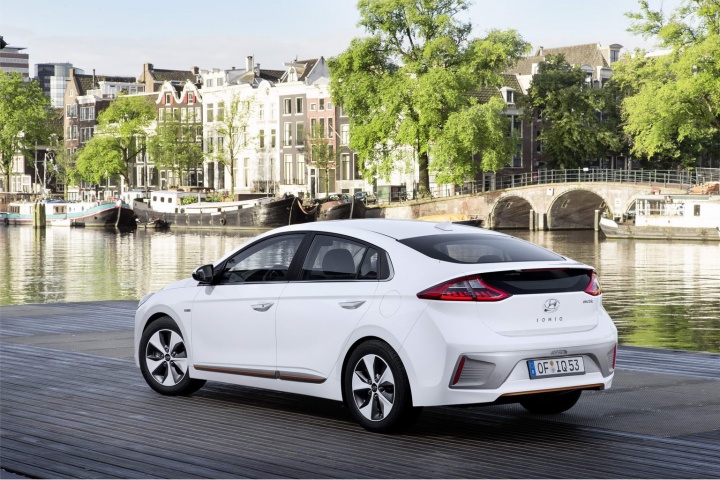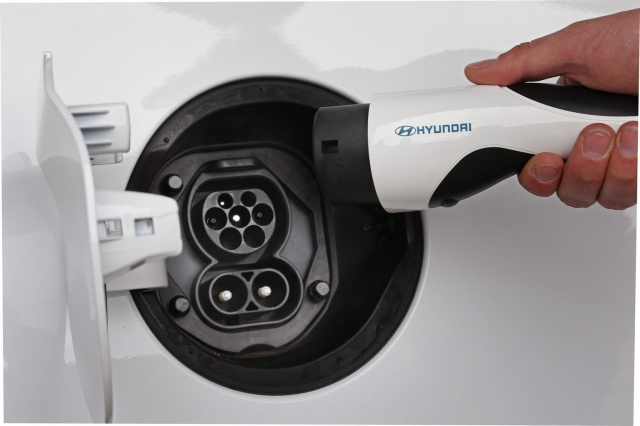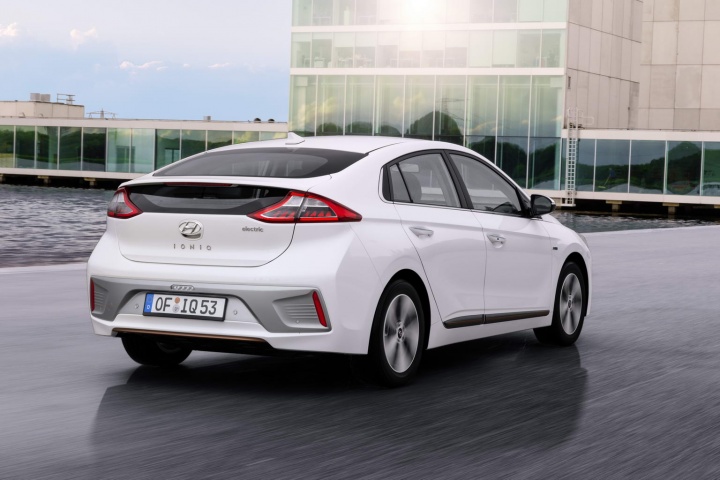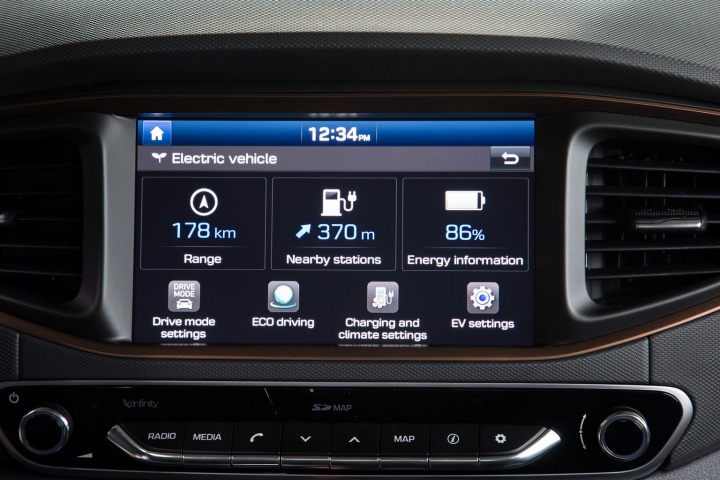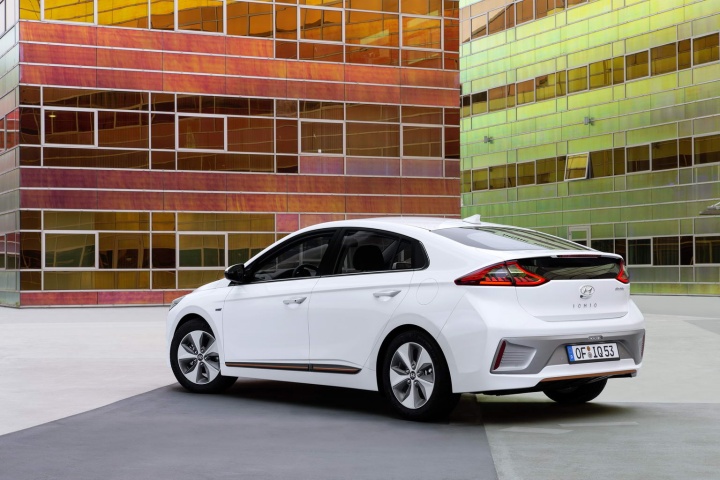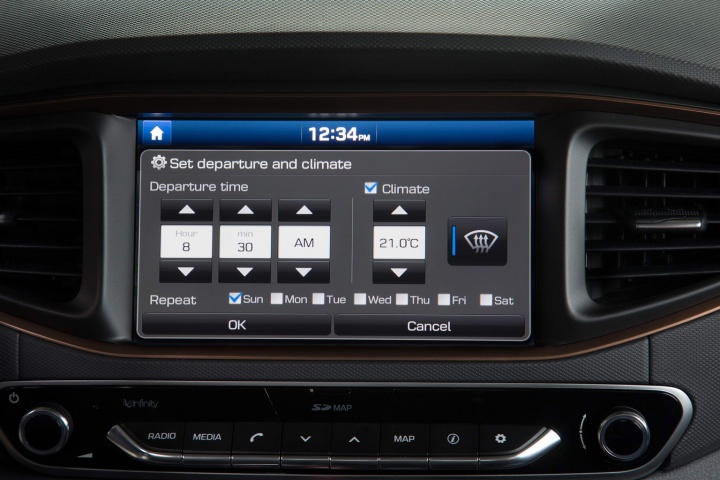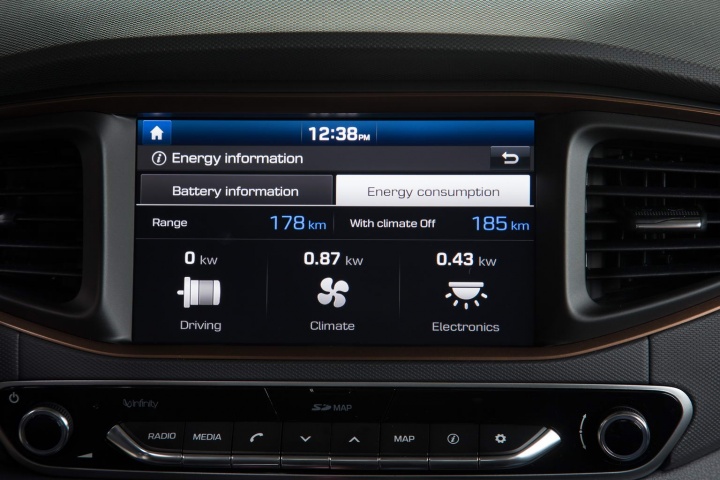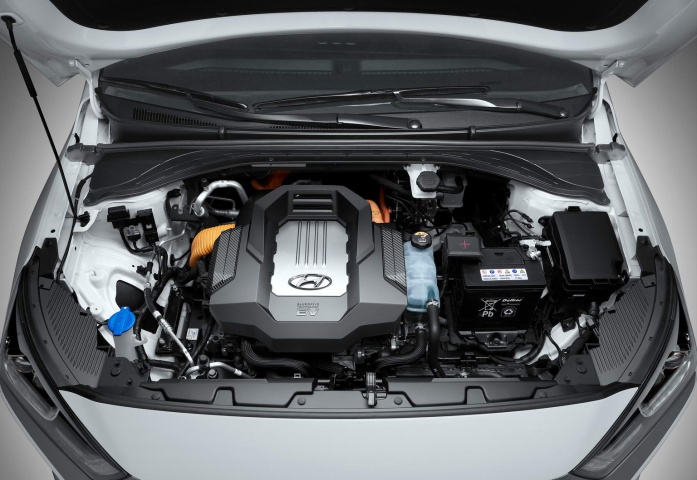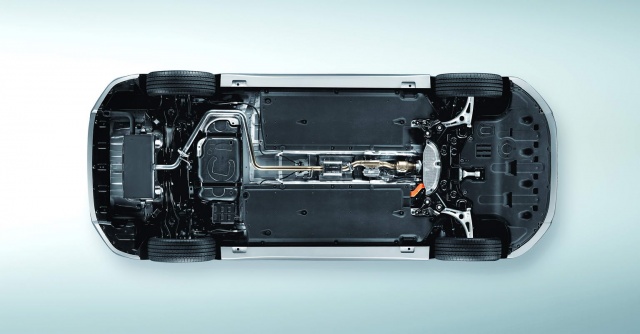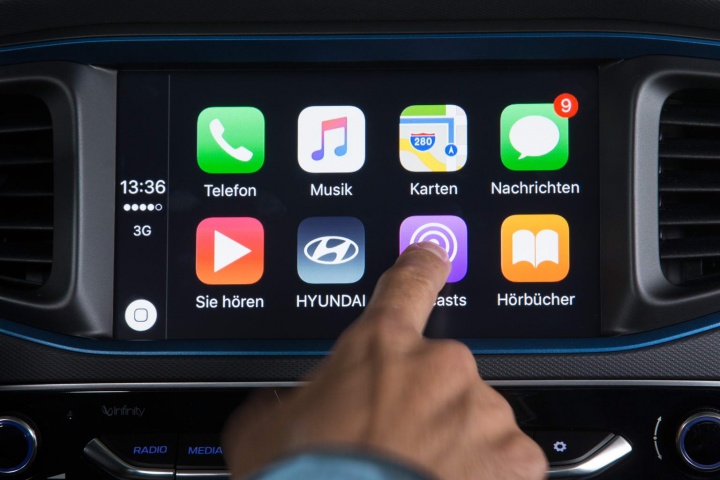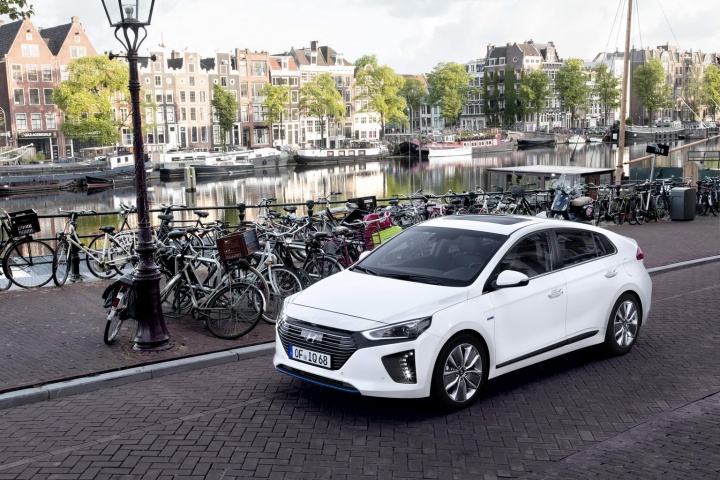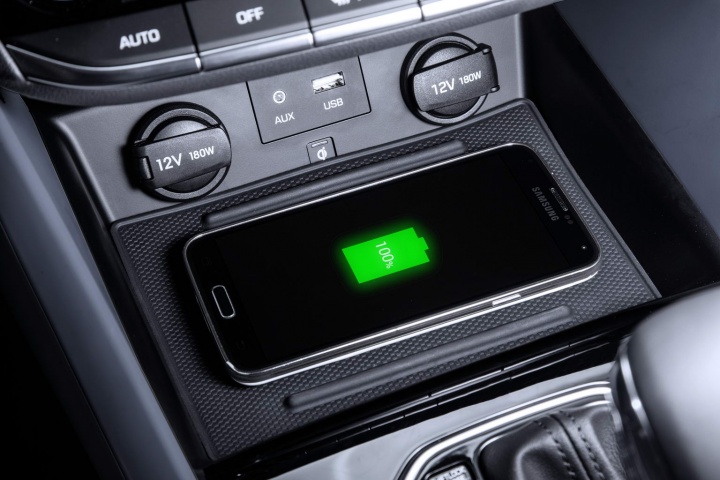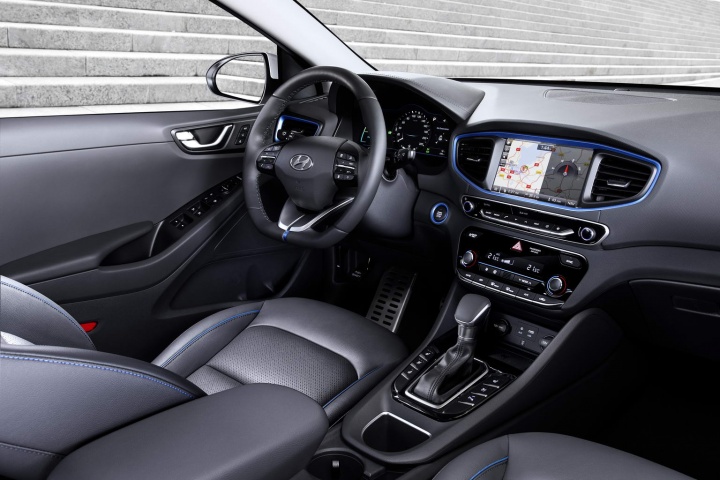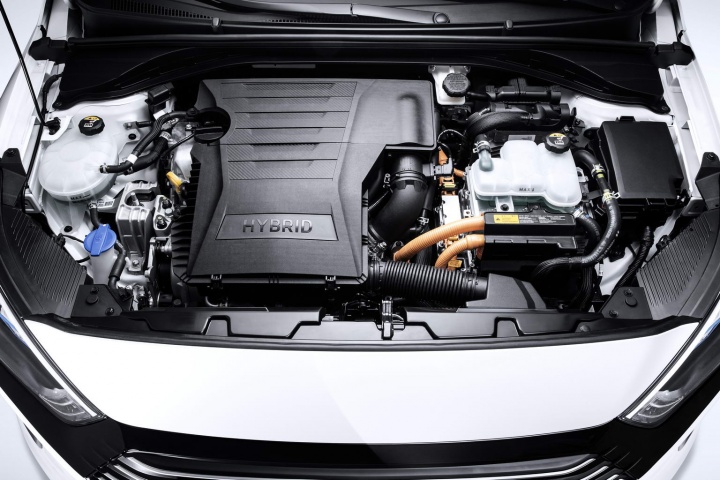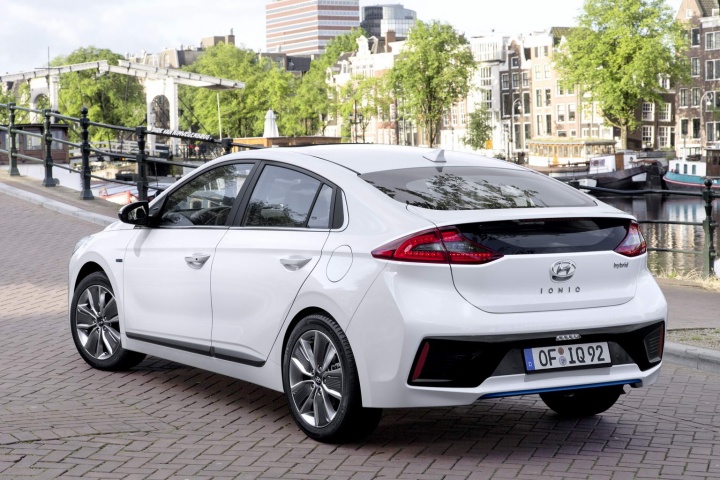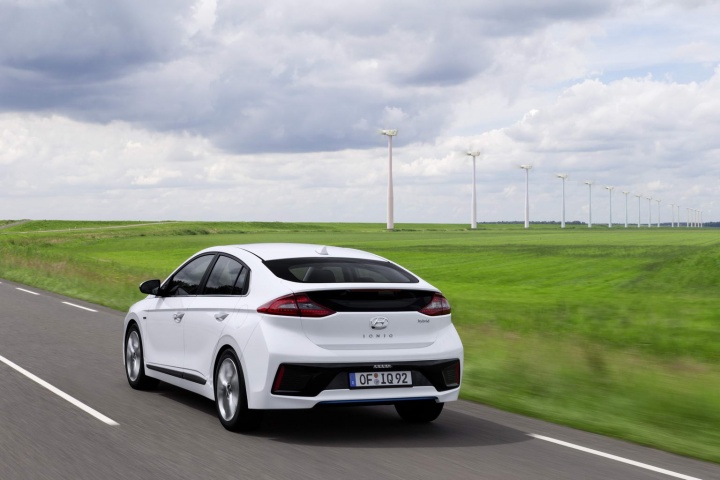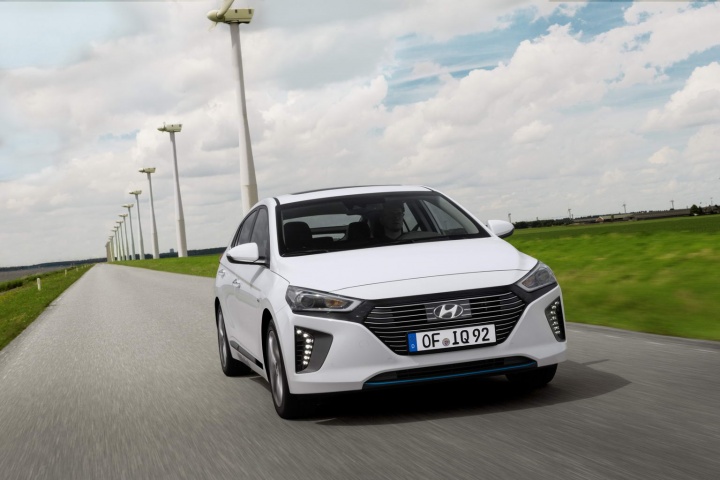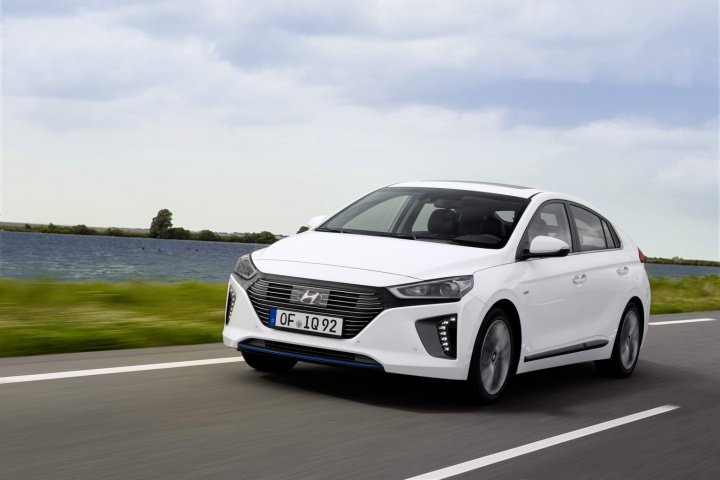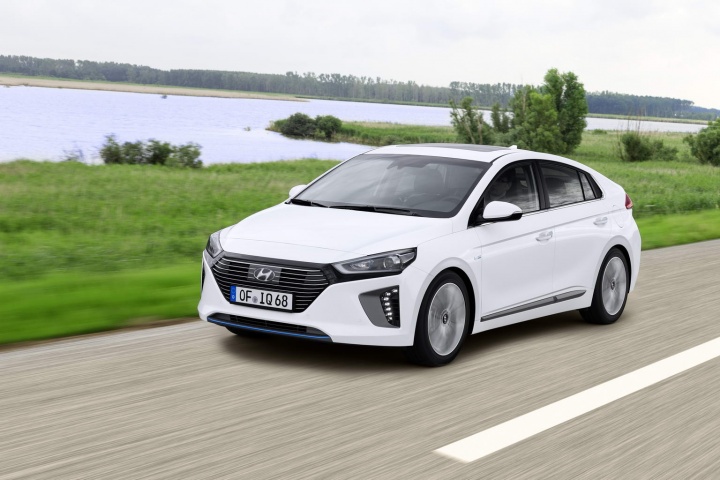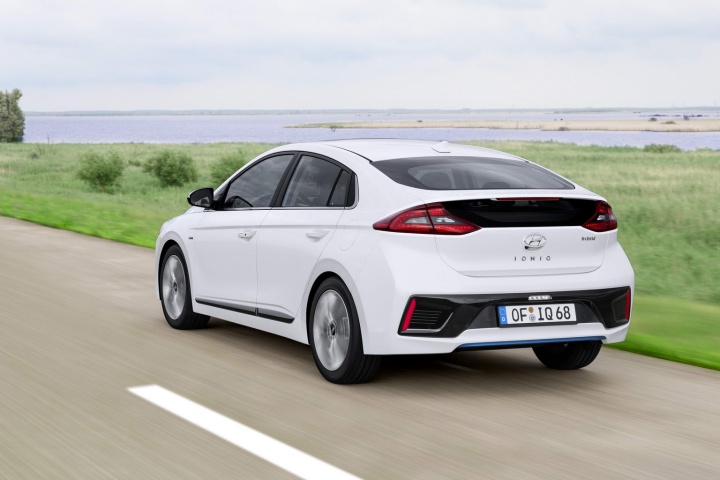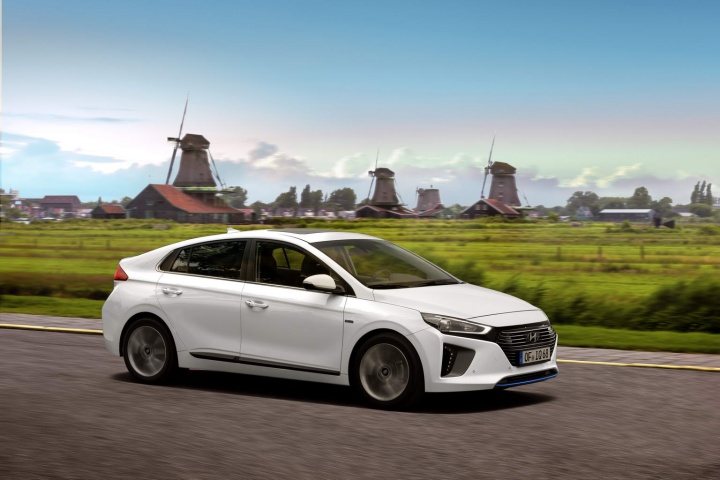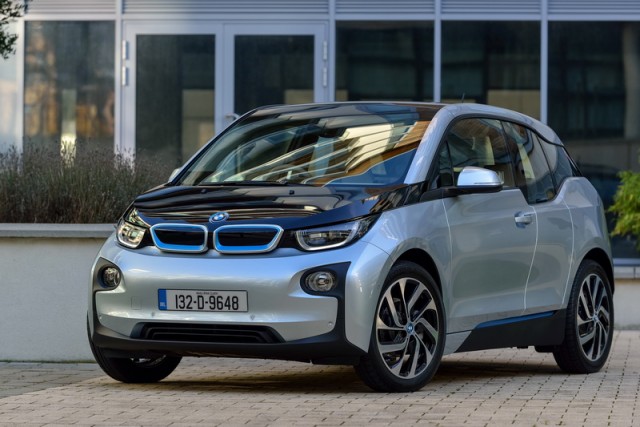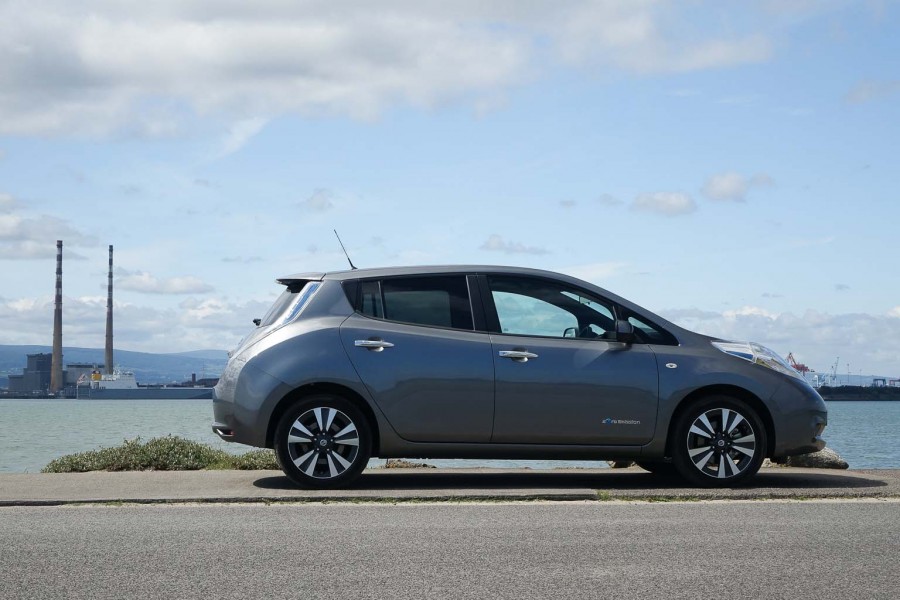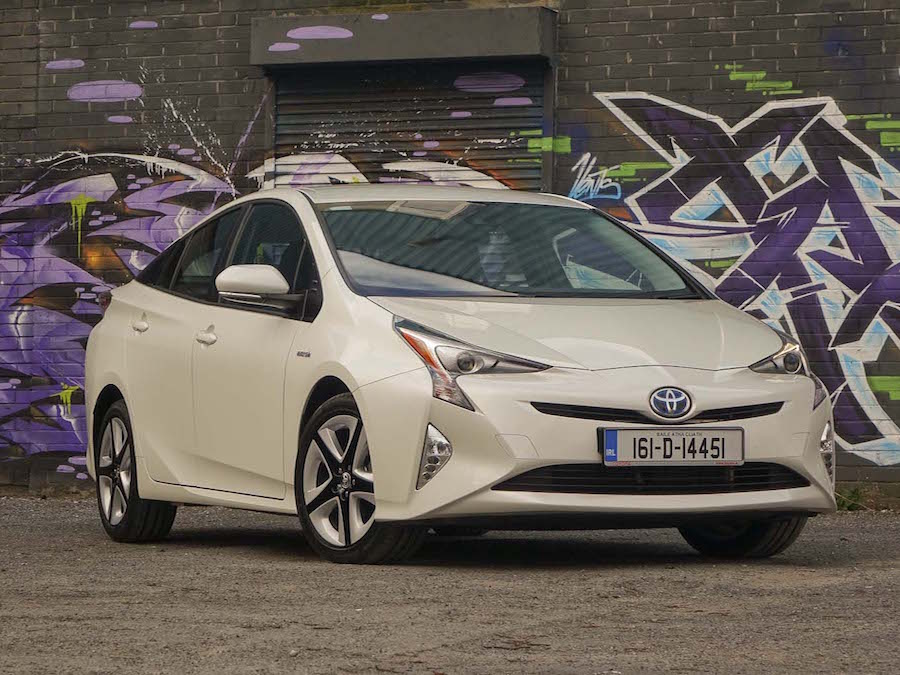Hyundai looks like it has a winner on its hands with the Ioniq hatchback, a model that offers multiple electrified drivetrain options in one body style. The plug-in hybrid version coming in 2017 might prove to be the best of both worlds, but both the parallel Hybrid version and the truly excellent Ioniq Electric already look strong contenders in their respective marketplaces.
In the metal
Although the Hyundai Ioniq Hybrid and Ioniq Electric models look very similar, look again; you should spot alternative colour themes and a few differences - some subtle, some not so - between the two. Chief of which is that the Electric, which has no need for a radiator grille to cool a combustion engine, has a smoothed-off silver nose cone that's impossible to miss. The Electric also uses a copper-colour for the strips at the lower edges of the front and rear bumpers, whereas the Hybrid has blue, the trim on the Electric's bumpers is silver instead of black and it runs on 16-inch alloys while the Hybrid has 15s as standard. You might also notice that the rear lamp clusters, which possess the same outline shapes, have marginally different arrangements of lights between Electric and Hybrid.
Nevertheless, whichever Ioniq you plump for, we really like the look of it. It's compact and elegant and has the swooping roofline that a lot of hybrid/EV cars have used to good effect, without looking too outlandish in the way, say, the current Toyota Prius does. In essence, the Ioniq has just the right amount of visual restraint, appearing to be a normal car, but having just enough design details to ensure you know it's part- or fully electric and to prevent it from being boring to gaze upon.
Same story in the interior, which we think is one of Hyundai's best. The Korean firm has used ecologically sourced materials, such as wood and rock powder, to fashion the fascias, but we didn't think they either felt or looked too bad at all. Indeed, in terms of design, it's one of Hyundai's neatest efforts, thanks in the main to the fully digital instrument cluster - a first in any of the company's cars. Once again, the differences here mean it's blue trim-detailing in the Hybrid and copper in the Electric, while the pure EV's larger lithium-ion battery pack knocks 93 litres off the Ioniq Hybrid's 443-litre boot capacity. Also, you'll spot the Electric has a flat panel of four buttons where the gear lever should be, while the Hybrid has a conventional automatic shifter. And that relates to some interesting drivetrain technology, so let's move onto that now...
Driving it
Starting with the Ioniq Hybrid, aimed squarely at the current Toyota Prius, this is impressive, but likely to be the least technologically awe-inspiring of the three Ioniq models, even though it's also sure to be the easiest to live with. It has a normally aspirated 1.6-litre GDI petrol four-cylinder engine, coupled to a modest 32kW permanent magnet synchronous motor with a 1.56kWh lithium-ion battery pack underneath the rear seats. That gives it a theoretical potential maximum range of more than 1,300km, thanks to a quoted consumption figure of 3.4 litres/100km (83.1mpg), although you need to avoid the 17-inch wheels that are on option on higher-grade cars, as these negatively affect both performance and economy. We saw 4.4 litres/100km (64.2mpg) on the flat roads around Amsterdam, which means more like 1,000km if you can emulate the same consumption on a regular basis.
It's a fine car, the Ioniq Hybrid, proving to be quiet, refined and smooth as the electric motor hands over to the combustion engine and vice versa. The absolute masterstroke, though, was choosing to fit the car with a dual-clutch transmission (DCT), instead of a continuously variable (CVT) item as found on the Prius. Now, we can't stand most CVTs because they're noisy and make for weird-feeling acceleration - and while the Ioniq Hybrid is hardly quick, with a 10.8-second 0-100km/h time, it just feels so much more responsive than anything fitted with a CVT. You press the throttle, the DCT kicks down and you're off. It's lovely.
That predisposes us to like the Ioniq more than it probably merits, although its system maximums of 141hp and 265Nm are a long, long way ahead of the Prius' 122hp and 165Nm. However, the Ioniq Hybrid, despite having multilink rear suspension (the Electric has to make do with a torsion beam, due to the packaging constraints of the larger battery), never really proves that entertaining to drive. The segue between the energy harvesting section of the brake travel and digging into the actual stopping power doesn't feel well calibrated, while the two-stage steering is also so-so; it's light, precise but lacking feedback in Eco mode and a bit too heavy and artificial in the Sport setting. The result is that the Hyundai is a composed car in the corners, but never that interesting. Better to revel in its supple ride comfort and the superb suppression of external noises when in the cabin, which is where the Hybrid makes its strongest case.
However, step into the Electric and it's clear to see which is the main attraction in the line-up. All of the Ioniq's data makes for impressive reading, because a 280km range on a full charge is remarkable for this class of car; the Nissan Leaf 30kWh model is claimed to cover 250km, BMW's 29kWh i3 (much more expensive) is reckoned to do 300km and the much less powerful/torquey Renault Zoe musters up a mere 210km. For Hyundai to start from scratch with such a long-legged EV is a magnificent effort from the Koreans.
And the car as a whole is just fantastic. The torsion beam rear gives it an even nicer ride than the Hybrid and there's less tyre roar noticeable in the Electric than there is in its sibling on the 17-inch wheels; given that in a pure EV, you often hear road and wind noise more readily thanks to the absence of a combustion motor, that's another big plus. The key word here is normalcy - for all its clever EV status, the Hyundai Ioniq Electric just feels like a regular five-door hatchback to drive. The value of such a characteristic cannot be underestimated.
You'll also notice that the Ioniq Electric has paddles on the steering wheel, but as it has a single-speed reduction gear, these have nothing to do with the gearbox. Instead, they control the level of regenerative braking on the car, through four stages. In the most powerful and next-most powerful settings, driving the Electric on one pedal alone is eminently achievable, such is the potent level of retardation on offer. Using regen braking as much as we could and making rather quick progress on the same flat Amsterdam roads as the Hybrid, our car covered 80km and was still showing 140km of range left in the tank; meaning with more careful driving, the 280km range doesn't look like it would be a fairy tale. Charging the car, by the way, takes 10 to 12 hours on a domestic socket, 4 to 6 hours on a fast home charger or untethered public charging points and you can put 80 per cent of the battery's maximum back into it in just 33 minutes on a rapid, tethered public charging point.
What you get for your money
Prices are yet to be confirmed for Ireland, but expect the Ioniq Hybrid to be somewhere around the Toyota Prius' €31,000 starting price. The Plug-in, due for release in 2017, will be a little more again, but should qualify for a €5,000 plug-in grant from the SEAI plus a further €2,500 of VRT relief. The Electric, meanwhile, in other markets is the priciest Ioniq of all, although it will be subject to a €10,000 rebate as full EVs get the maximum €5,000 of VRT relief here.
Specification is another area where anything is yet to be confirmed by Hyundai Ireland, but as the cars on test were fitted with plenty of luxuries, driver assist safety systems and connectivity packages, we'd expect the Ioniq to be well-equipped when trim grades are confirmed for Ireland. Finally, all Ioniqs qualify for the standard five-year, unlimited mileage manufacturer warranty, while the lithium-ion battery on every model comes with an eight-year, 200,000km warranty.
Summary
The Hyundai Ioniq looks attractive on the outside without being either divisive or dull. It has a decent quality interior with lovely design and a crisp TFT instrument cluster, as well as enough room for four adults (headroom in the rear is tighter for tall people, thanks to the roofline of the car) and a useful boot. And it drives in a pleasant, comfortable manner no matter which of the drivetrains you decide to go for.
We think the Hybrid model is very good and we'd have one over its natural rival, the Prius, which is a remarkable performance from Hyundai, seeing as Toyota has been making its contender since 1997. But, until we get a go in the Ioniq Plug-in, our favourite has to be the Electric. Blending the routine driving manners of a normal car with the benefits of an EV, it's a really well-rounded package and one of the best electrified vehicles out there, irrespective of price or size. As first efforts go, this is a stellar production from Hyundai.

